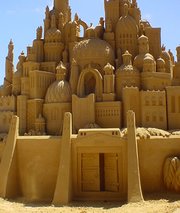Sand art and play
|
|
A sand castle is a type of sand sculpture which resembles a miniature building, often (but not always) a castle. The two basic building ingredients, sand and water, are available in abundance on a sandy beach and so most sand play occurs there, or in a sandbox.
A variant on the sand castle is the drip castle, made by mixing extra water in with the sand, and dripping this wet sand from a fist held above. When the sand/water slurry lands on existing sand structures, the water is rapidly wicked away leaving the blob of sand in place. The effect is Gaudi-esque.
Sand castles are typically made by children, simply for the fun of making them. However, adults sometimes engage in contests making sand sculptures, in which the goal is to create structures which don't appear to be constructed just from sand; they can become large and complex. Other vulnerable media are ice and snow, leading to ice sculptures and snow sculptures.
On the other hand, adults can find sand castle construction to be almost "Zen-like" in its ability to create total focus and relaxation. Whether an hour or a day, alone or with a group of friends or family, sand castle play is increasingly seen as adult leisure time activity for beach vacationers.
An example of extremely sophisticated sand art is the Buddhist mandala. Template:Commons
| Contents |
Construction
DSCN1480.JPG
The main tools for construction are a shovel (although using the hands only is also common) and a bucket or other container to bring water from the sea to the "construction site". Also pieces of wood etc. can be used to reinforce structures.
Sand sculpting has been around for many decades and has become very popular more recently with hundreds of competitions held all over the world every year. It has become quite sophisticated and can be found in the book of world records as well as in many commercial and promotional applications. Some advocates are purists using no artificial materials, no forms or coloring, no glue or heavy machinery. One such artist, G. Augustine Lynas has been doing public works for 50 years usually with an environmental messase associated with his sculptures. He designs them to be gradually destroyed by the tide encouraging emotional attachment to the disappearing art. The works are usually representational, often combining anatomical forms with architecture and landscape. Some pieces are enormous, some small. A few are dry and low relief and others tall and highly detailed. Some employ optical illusions or gravity defying undercuts. His book and film titled "Sandsong" have been available through his website of the same name.
Alternatives to sand castles
Small_sand_castle.jpg
One of the main attractions of a sandy beach, especially for children, is playing with the sand, with more possibilities than a sandbox. One can make a mountain, a pit (encountering clay or the water table), canals, tunnels, bridges, a sculpture (representing a person, animal, etc. like a statue, or a scale model of a building), etc. Tunnels large enough to enter should be strongly discouraged; children have been killed by collapses of underground chambers and such a collapse is guaranteed if wave swash reaches the structure. If a small stream enters the beach, one or more dams can be constructed to hold back lakes of stream water. Almost as much fun as building beach dams is deliberately breaking them to cause a flood. If the beach is at an ocean, or at a sea connected to an ocean then there can be tides. These tides add attractive dynamics: on flood-tides the rising water enters previously dry ditches and pits, and one can try to keep areas dry by dikes, etc.; on ebb-tides one can try to keep water in a canal by deepening it and lenghtening it, keeping it connected to the retracting sea. If one returns the next day much erosion is apparent—in fact only large excavations at all survive one excursion of the tide, and beach dynamics soon enough smooth out the surface, erasing everything.
See also
External links
- Sand Castle Central (http://www.sandcastlecentral.com)
- Team Sandtastic (http://www.teamsandtastic.com)
- sandy feet: sand castle wizard (http://www.sandyfeet.com/sand/main.html)de:Sandburg
es:Castillo de arena it:Castello di sabbia he:ארמון חול ja:砂遊び sv:Sandslott zh:沙雕

